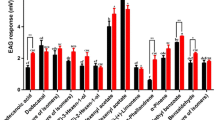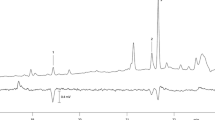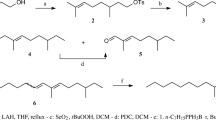Abstract
The sex pheromone of the American population of Lyonetia prunifoliella (Lepidoptera: Lyonetiidae) was reported to be composed of three components, 10,14-dimethyloctadec-1-ene (10me14me-1-ene-18Hy), 5,9-dimethyloctadecane (5me9me-18Hy), and 5,9-dimethylheptadecane (5me9me-17Hy). Studies with a Korean population showed that the 10S,14S isomer of the major compound was the major electrophysiologically by active stereoisomer. The 5S,9S isomers of the minar constituents also elicited electrophysiological responses. In field trappings, among the three components, the racemic mixture of 10me14me-1-ene-18Hy attracted L. prunifoliella males strongly, and the binary or tertiary combinations with racemic mixtures of the other two components did not increase trap catches. Among the four stereoisomers of 10me14me-1-ene-18Hy, only the 10S,14S isomer attracted L. prunifoliella males, as suggested by the EAG test, and attraction to the other three isomers was not observed. All stereoisomers of each minor component, as well as their racemic components, did not seem to have any additional effect on male attraction in Korea.
Similar content being viewed by others
REFERENCES
Boo, K. S. 1998. Variation in sex pheromone composition of a few selected lepidopteran species. J. Asia-Pac. Enntomol. 1:17–23.
Brown, M.W. 1989. Spatial dynamics and sampling of Lyonetia specuella (Lepidoptera: Lyonetiidae), a new leafminer of apple. Environ. Entomol. 18:875–880.
Cork, A., BOO, K. S., DUNKELBLUM, E., HALL, D. R., JEE, K., KEHAT, M., KONG, JIE, E., PARK, K. C., TEPGIDAGARN, P., and LIU Z. 1992. Female sex pheromone of oriental tobacco budworm, Helicoverpa assulta (Guenee) (Lepidoptera: Noctuidae): Identification and field testing. J. Chem. Ecol. 18:403–418.
Francke, W., TÒTH, M., SZÖCS, G., KRIEG, ERNST, H., and BUSCHMANN, E. 1988. Identifizierung und Synthese von Dimethylalkanen als Sexuallockstoff weiblicher Miniermotten (Lyonetiidae). Z. Naturforsch. 43c:787–789.
Gries, R., GRIES, G., KING, G. S., and MAIER, C. T. 1997. Sex pheromone components of the apple leafminer, Lyonetia prunifoliella. J. Chem. Ecol. 23:1119–1130.
King, G. G. S., GRIES, R., GRIES, G., and SLESSOR, K. N. 1995. Optical isomers of 3,13-dimthylheptadecane sex pheromone components of the western false hemlock looper, Nepytia freemani (Lepidoptrea: Gemonetridae). J. Chem. Ecol. 21:2027–2045.
Li, J., GRIES, R., GRIES, G., SLESSOR, K. N., KING, G. G. S., BOWERS, W. W., and WEST, R. J. 1993. Chirality of 5,11-dimthylheptadecane, the major sex pheromone component of the hemlock looper, Lambdina fiscellaria (Lepidoptera: Geometridae). J. Chem. Ecol. 19:1057–1062.
Nakamura, Y. and MORI, K. 2000. Pheromone synthesis, CCIV. Synthesis of the enantiomers of anti-2,6-dimethylheptane-1,7-diol monotetrahydropyranyl ether and their conversion into the enantiomers of the sex pheromone components of the apple leaf miner, Lyonetia prunfoliella. Eur. J. Org. Chem. 2745–2753
Riba, M., ROSELL, M., EIZAGUIRRE, T., CAMELA, R., and GUERRERO, A. 1990. Identification of a minor component of the sex pheromone of Leucoptera malifoliella. J. Chem. Ecol. 16:1471–1483.
Sato, R., ABE, N., SUGIE, H., KATO, M., MORI, K., and TAMAKI, Y. 1986. Biological activity of the chiral sex pheromone of the peach leafminer moth, Lyonetia clerkella Linne (Lepidoptera: Lyonetiidae). Appl. Entomol. Zool. 21:478–480.
Schmitt, J. J., BROWN, M. W., and DAVIS, D. R. 1996. Taxonomy, morphology, and biology of Lyonetia prunifoliella (Lepidoptera: Lyonetiidae), a leafminer of apple. Ann. Entomol. Soc Am. 90:334–345.
Sekita, N. M. and YAMADA, M. 1979. Life history of Lyonetia prunifoliella H¨ubner subsp. malinella (Matumura) (Lepidoptera: Lyonetiidae). Appl. Entomol. Zool. 14:285–292.
Sugie, H., TATSUKI, S., NAKAGAKI, S., RAO, C. B., and YAMAMOTO, A. 1991. Identification of the sex pheromone of the oriental tobacco budworm, Helicoverpa assulta. (Guenee) (Lepidoptera: Noctuidae). Appl. Entomol. Zool. 26:151–153.
Tamagawa, H., TAKIKAWA, H., and MORI, K. 1999. Synthesis of all the stereoisomers of 10,14-dimethyloctadec-1-ene, 5,9-dimethyloctadecane and 5,9-dimethylheptadecane, the sex pheromone components of the apple leafminer, Lyonetia prunifoliella. Eur. J. Org. Chem. 973–978.
TÒth, M., HELMCHEN, G., LEIKAUF, U., SZIRÁKI, G., and SZÖCS, G. 1989. Behavioral activity of optical isomers of 5,9-dimethylheptadecane, the sex pheromone of Leucoptera scitella L. (Lepidoptera:Lyonetidae). J. Chem. Ecol. 15:1535–1543.
Yamada, M., OYAMA, N., SEKITA, N., SHIRASAKI, S., and TSUGAWA, C. 1970. Forecasting the outbreak of destructive insects in apple orchards. VIII on the biology of the leaf miner, Lithocolletis ringoniella Matumura, on apples in Tsugaru-district and 1964's explosion at Hiraka-Town. Bull. Aomori Apple Exp. Stn. 14:1–27.
Author information
Authors and Affiliations
Corresponding author
Rights and permissions
About this article
Cite this article
Park, J.H., Han, K.S., Mori, K. et al. Right Stereoisomers for Sex Pheromone Components of the Apple Leafminer, Lyonetia prunifoliella, in Korea. J Chem Ecol 28, 2515–2525 (2002). https://doi.org/10.1023/A:1021488103491
Published:
Issue Date:
DOI: https://doi.org/10.1023/A:1021488103491




